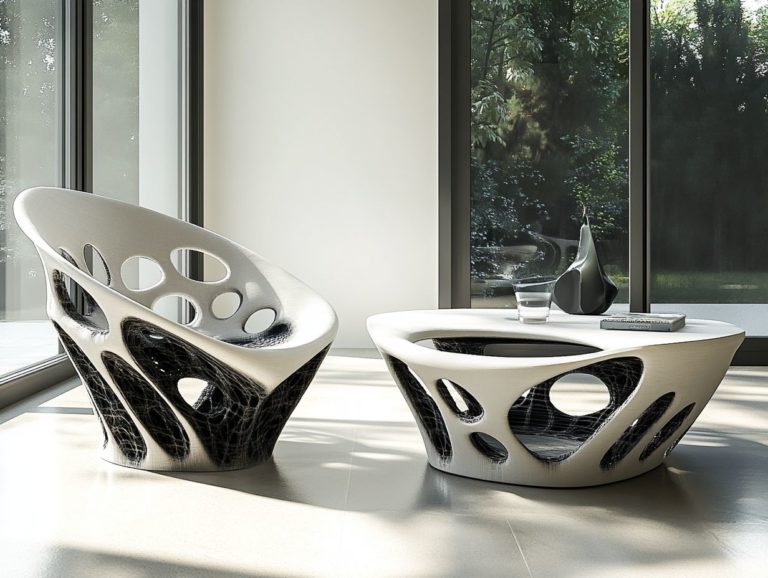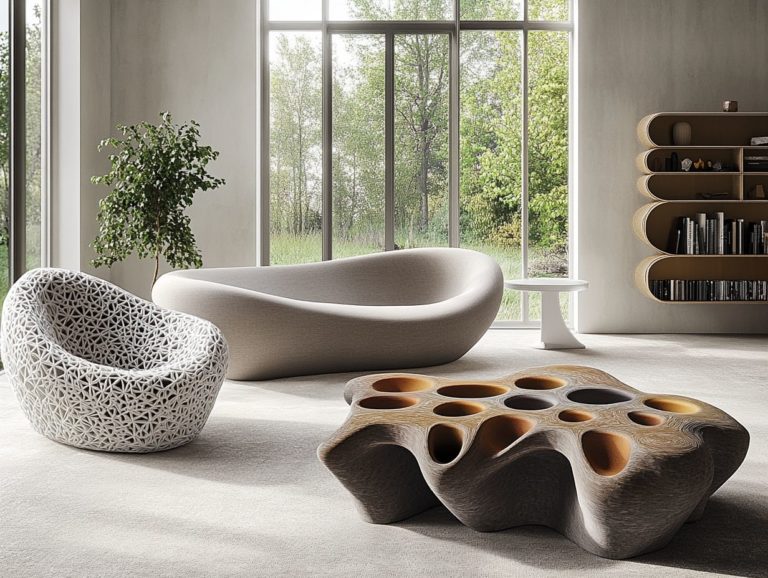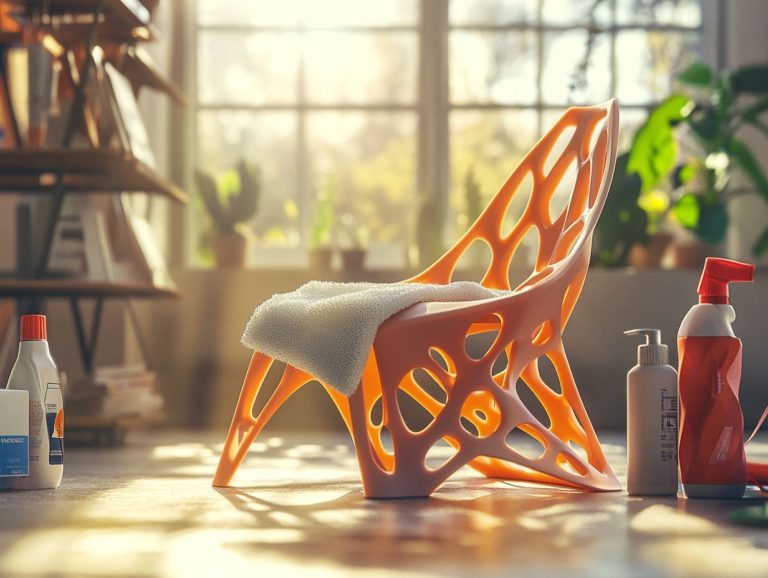The Rise of 3D-Printed Furniture: An Overview
The furniture manufacturing landscape is currently undergoing a remarkable transformation, shifting from traditional craftsmanship to the cutting-edge world of 3D printing technology.
Let’s dive into how furniture production is changing for the better, illuminating the stark contrasts between time-honored techniques and contemporary innovations.
You ll uncover the numerous advantages of 3D-printed furniture, which range from enhanced efficiency and unparalleled customization to promising prospects for environmental sustainability. However, challenges and limitations, including material constraints and costs, still linger.
Join in as we examine the current applications and future implications of this revolutionary approach to furniture design.
Contents
Key Takeaways:
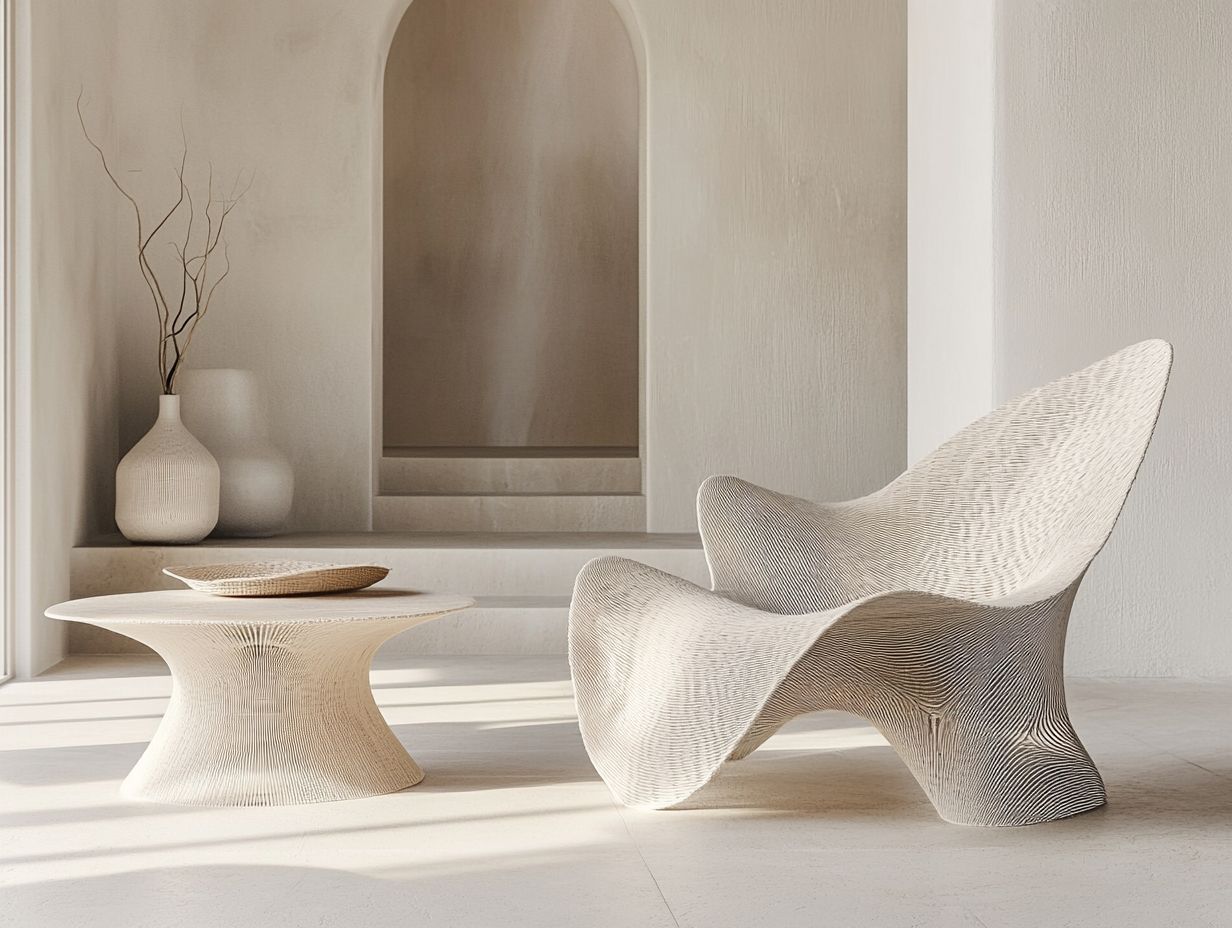
- 3D-printed furniture offers increased efficiency and customization compared to traditional manufacturing methods.
- 3D-printed furniture is eco-friendly, using recycled materials and generating less waste.
- However, material limitations and high costs may present challenges for widespread adoption and accessibility.
The Evolution of Furniture Manufacturing
The evolution of furniture manufacturing has experienced remarkable transformations, especially with the rise of 3D printing technology. This innovation is reshaping traditional manufacturing methods and paving the way for new designs that are both cost-effective and environmentally friendly.
Thought leader Nathaniel Berman emphasizes how the furniture industry is fully embracing these advancements, fostering a shift toward more creative expressions that redefine domestic architecture and revolutionize furniture business models.
Traditional Methods vs. 3D Printing
Traditional methods of furniture manufacturing often rely on established techniques that emphasize durability and craftsmanship. However, 3D printing introduces a realm of design freedom and cost-effectiveness, allowing you to create intricate geometries previously thought impossible.
This innovative technology effectively overcomes the limitations of conventional production methods, tackling issues like long lead times, material waste, and the lack of customization.
Traditional manufacturing usually necessitates significant material reductions for cutting and shaping, which often results in considerable waste. In contrast, 3D printing uses materials more efficiently, enabling on-demand production that perfectly suits your needs.
With 3D printing, the ability to easily modify designs allows manufacturers to swiftly adapt to consumer preferences, enhancing personalization while reducing the necessity for large inventories. These advancements mark a significant shift toward a more sustainable, flexible, and customer-centric approach in the ever-evolving landscape of manufacturing technologies.
Benefits of 3D-Printed Furniture
3D-printed furniture presents a multitude of advantages that align seamlessly with contemporary consumer trends. You’ll enjoy enhanced customization options, allowing you to create pieces that truly reflect your personal style.
The use of sustainable materials supports eco-friendly practices and meets the growing demand for responsible consumption. With the capability for rapid prototyping, you can explore innovative design solutions tailored specifically to your preferences and needs, making each piece uniquely yours.
Efficiency and Customization
The efficiency of 3D printing technology dramatically accelerates your design and manufacturing process, enabling you to create personalized furniture that resonates deeply with consumer behavior and preferences.
This new method not only streamlines production but also allows you to express your unique tastes through a variety of customizable options. As you increasingly search for pieces that embody your individual lifestyle, 3D printing rises to the occasion by quickly adapting designs based on your feedback and current market trends.
This capability gives the power to manufacturers to strike a balance between the necessity for mass production and the burgeoning demand for personalization, resulting in a seamless fusion of efficiency and custom craftsmanship.
Such a transformation in the industry not only elevates your satisfaction as a consumer but also optimizes resources, ultimately reducing waste and championing sustainability.
Environmental Sustainability
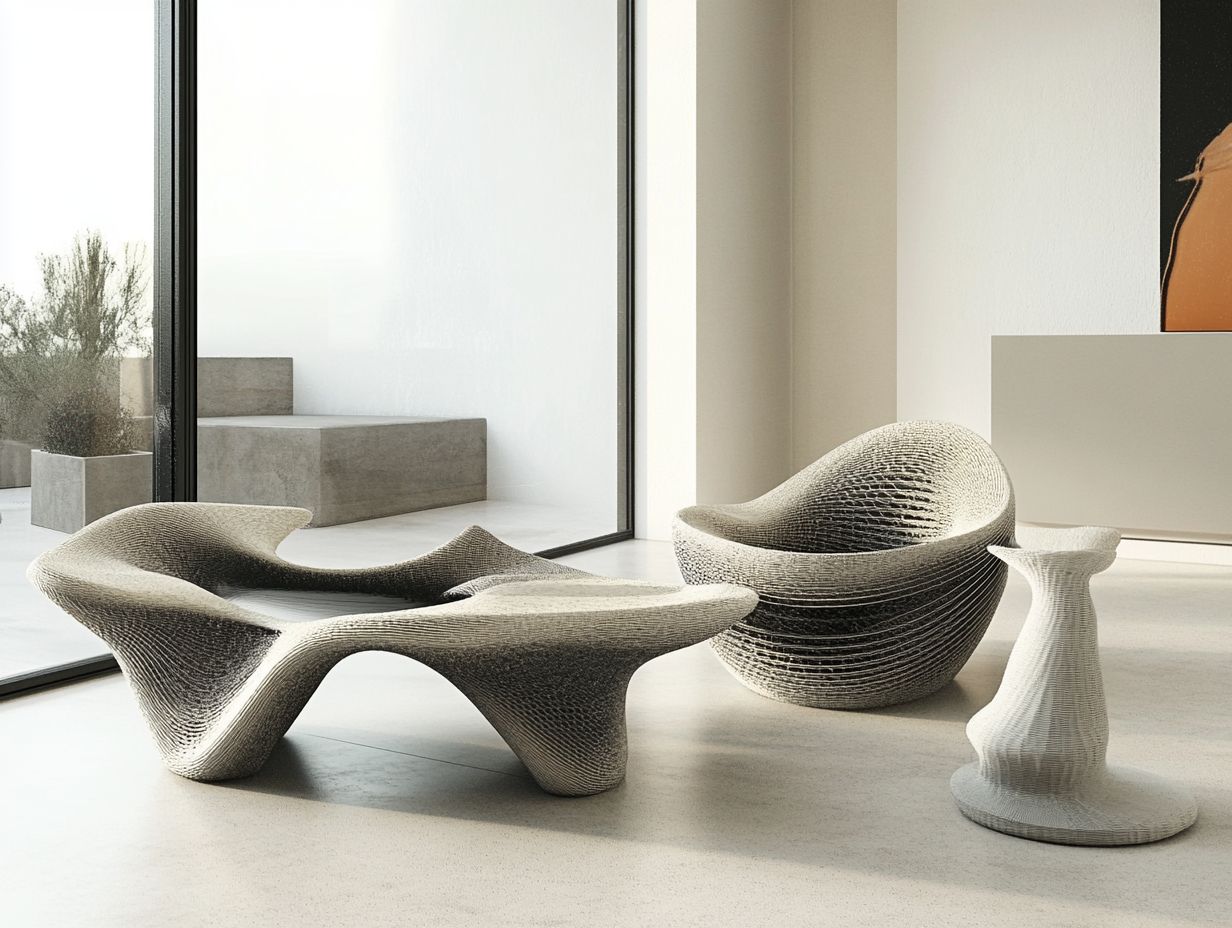
Emphasizing environmental sustainability, you ll find that 3D-printed furniture makes use of sustainable materials and aligns perfectly with the principles of a circular economy, a system where resources are reused and recycled. This approach minimizes waste and promotes resource efficiency throughout the manufacturing process.
Adopting this innovative method not only lowers the amount of pollution created linked to traditional production techniques but also gives the power to designers to craft unique, customizable pieces tailored to your individual needs. By utilizing biodegradable or recycled materials, the furniture industry can significantly reduce its dependence on non-renewable resources, fostering a more responsible use of the Earth s materials.
Current material limitations allow manufacturers to implement making things only when they’re needed, which further diminishes excess inventory and the waste that comes with it, supporting broader sustainability efforts. This shift toward eco-friendly practices showcases a promising future where style and environmental responsibility can harmoniously coexist.
Challenges and Limitations of 3D-Printed Furniture
Despite the numerous advantages of 3D-printed furniture, you might face some challenges, but overcoming them is crucial for success. Issues related to material choices, production costs, and accessibility can often stand in the way of fully realizing its potential in the furniture market.
Material Limitations
One of the primary material limitations you ll encounter with 3D-printed furniture is the availability and performance of better materials. This can hinder your ability to produce lightweight prototypes and affect overall durability.
Consider this: while some materials may offer that sought-after flexibility and aesthetic allure, they often fall short on the strength needed for long-term functional use. This creates a dilemma for you as a designer, forcing you to compromise either the intricacy of your visions or the durability of the end product.
The current material limitations can lead to frequent adjustments in your designs, which inevitably extends the design cycle. As a result, you may find yourself navigating a landscape where your creativity is often constrained by the resources at your disposal, ultimately impacting the market viability of your innovative concepts.
Cost and Accessibility
The cost of implementing 3D printing technology can be a significant barrier for many businesses in the furniture industry, impacting accessibility and the overall economic efficiency of adopting this innovative approach.
You might find that the high initial investment in equipment and materials, coupled with ongoing maintenance costs, often discourages smaller companies from exploring this cutting-edge manufacturing method. Factors like changing material prices and the need for specialized workforce training can complicate matters even further.
However, there are several strategies you can explore to mitigate these challenges, such as:
- Pooling resources to share technology
- Leveraging government subsidies
- Investing in collaborative partnerships with 3D printing specialists
By navigating these economic hurdles, you can unlock the potential of 3D-printed furniture, making it more accessible and sustainable for a broader audience. Explore how you can leverage these technologies today!
Current Applications of 3D-Printed Furniture
Current applications of 3D-printed furniture offer a stunning array of innovative pieces that redefine both aesthetics and functionality across diverse environments, whether in residential spaces or bustling commercial settings.
Examples of 3D-Printed Furniture in Use
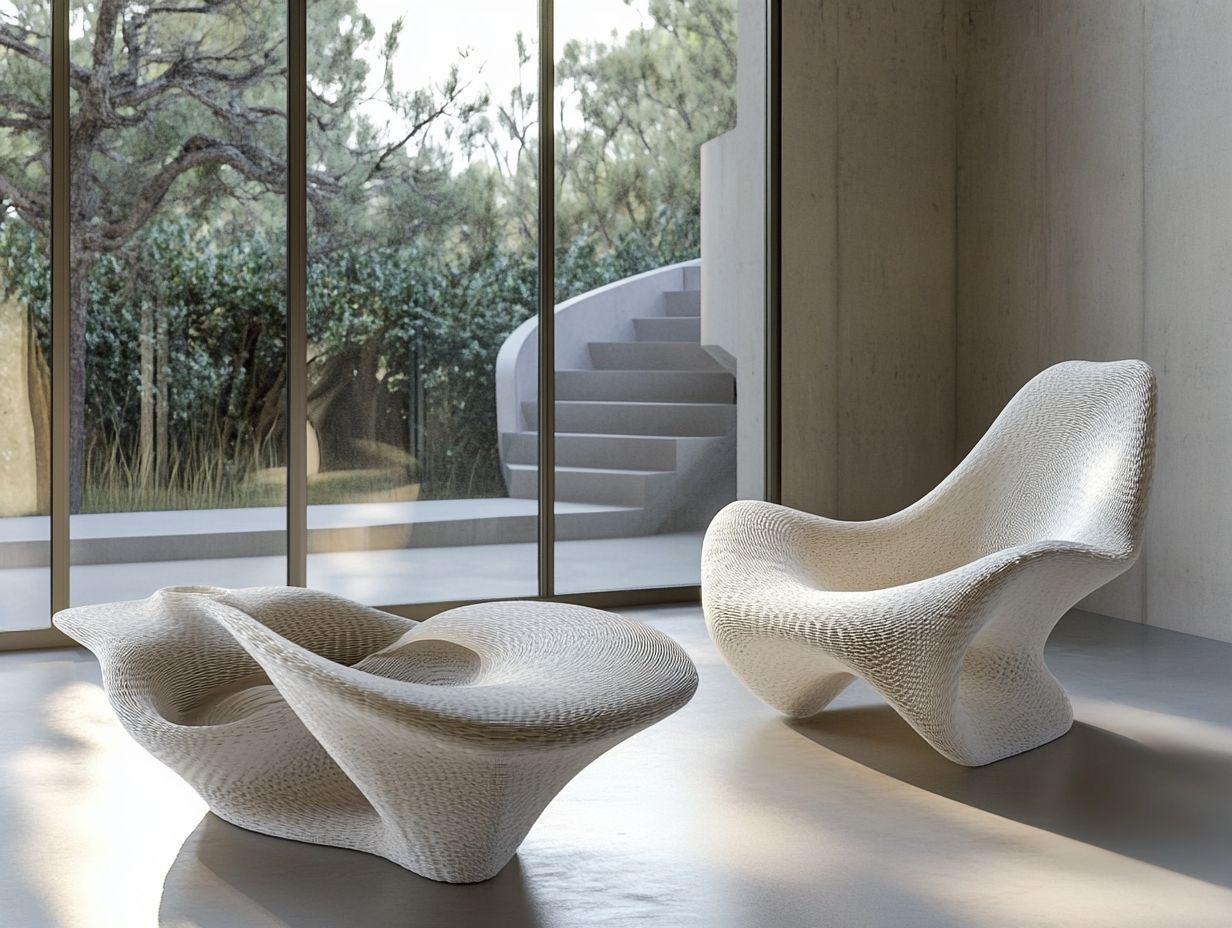
Examples of 3D-printed furniture include standout creations like the One Shot Stool by Patrick Jouin, the Bloom lamp, and Dirk Vander Kooij’s Endless Pulse Chair.
Each of these pieces exemplifies the remarkable potential of this innovative technology. These designs showcase the ingenuity of their creators and highlight how 3D printing is transforming the furniture industry.
Take the One Shot Stool, for example it seamlessly blends form and function in a single process. The result is a unique, monoblock structure that is both durable and lightweight.
Then there’s the Bloom lamp, which boasts a floral-inspired design crafted using advanced algorithms. It elegantly illustrates how technology can emulate the beauty of the natural world.
On the other hand, the Endless Pulse Chair, with its graceful lines and eco-friendly materials, challenges the limits of what 3D printing can achieve.
Each of these designs serves a practical purpose while inviting you to rethink the connections between art, sustainability, and technology in contemporary furniture.
The Future of 3D-Printed Furniture
The future of 3D-printed furniture is exciting and full of opportunities! You are positioned to witness how this technology will influence consumer behavior and usher in a new era of bespoke design (custom-made) that balances economic efficiency with environmental sustainability.
Potential Impact on the Furniture Industry
The potential impact of 3D-printed furniture on the furniture industry is nothing short of revolutionary. It invites innovative designs and unparalleled levels of customization that truly cater to your diverse needs.
By leveraging advanced technologies, manufacturers can deliver tailored solutions that mirror your individual tastes and preferences. This transformation enhances both the visual appeal of your living spaces and addresses practical considerations like space management and material efficiency.
As you seek unique designs that resonate with your personal style, the furniture sector is poised for a metamorphosis. Traditional production methods are yielding to dynamic, on-demand manufacturing. The integration of 3D printing opens new avenues for creativity and streamlines the supply chain, leading to more sustainable practices that benefit both you and the environment.
Frequently Asked Questions
What is 3D-printed furniture?
3D-printed furniture refers to furniture pieces that are created using a 3D printer, a machine that uses digital designs to create three-dimensional objects by layering materials such as plastic or metal.
How is 3D-printed furniture made?

3D-printed furniture is made using a process called additive manufacturing, where the 3D printer lays down thin layers of material on top of each other until the desired shape is achieved. This method allows for greater design freedom and customization compared to traditional manufacturing methods.
What are the benefits of 3D-printed furniture?
There are several benefits to 3D-printed furniture, including the ability to create intricate and unique designs, reduced waste and material usage, and faster production times. It also allows for more sustainable and eco-friendly production methods.
Is 3D-printed furniture durable?
Yes, 3D-printed furniture can be just as durable as traditionally manufactured furniture. It all depends on the materials used and the design of the furniture piece. With advancements in technology and materials, 3D-printed furniture is becoming increasingly strong and long-lasting.
Explore 3D-printed furniture today to experience the future of design!
What are the limitations of 3D-printed furniture?
3D-printed furniture has size limitations. Most printers can only create smaller objects, making larger pieces challenging.
The materials used may also not be suitable for all furniture types.
How does the rise of 3D-printed furniture impact the furniture industry?
The rise of 3D-printed furniture is shaking up the traditional furniture market, as it opens doors for innovative designs and understanding the technology behind 3D-printed furniture.
Smaller designers and companies now have a chance to compete with larger brands.

